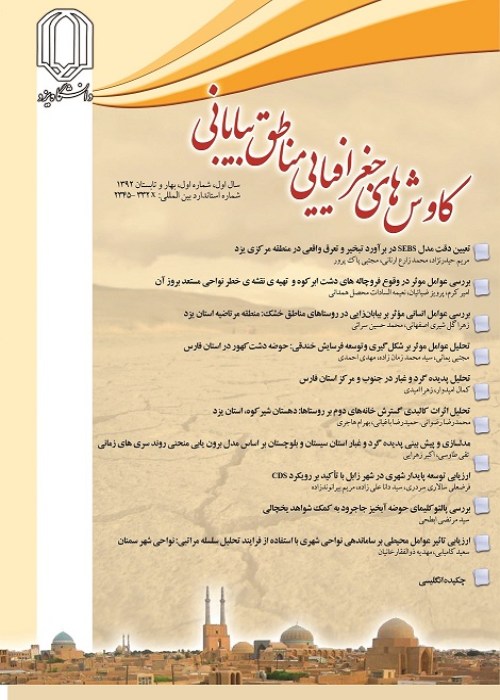Review of Learning City Indicators in the areas of Yazd city
Learning and the learning process (interactions between the learner and the social environment) is one of the topics for the development and excellence of today's urban communities.Globalization and economics, the growth of information technology, the transformation of the business world, the influence of customer orientation, the introduction of knowledge and learning as major assets, changing roles and expectations of employees, diversification and mobility of the workforce, rapid change and turmoil are some of the factors that create learning cities. Tensions and skills are constantly changing and growing, and this requires a continuous, quality and universal transfer of knowledge. Explaining the location of each of the main elements of the formation of the learning city in the Yazd city is an issue that can be carefully studied. In this regard, the main purpose of this study is to analyze the situation of Yazd city areas in terms of knowledge, social-legal and economic indicators, learning city and prioritize it and tries to study these indicators of learning city in Yazd city areas to create a learning city and strengthen the learning system. Lifelong for citizens to promote sustainable knowledge given the existing capacities that help to improve the urban environment (landscapes).
In this research, the library method, survey documents have been used to collect information. The present research is applied-developmental in terms of purpose and descriptive-analytical in terms of nature and method. In this research, cluster sampling method has been used. The process of extracting the indicators has been done by fission analysis method. Due to the specialization of the subject, the statistical community includes groups of experts and experts working in organizations related to the concept of the learning city of Yazd (including municipalities, schools, universities, companies, mobilization areas, organizations and libraries). The sample size is estimated based on Cochran sampling method of 320 people and was distributed in the form of a two-dimensional questionnaire in 8 areas of Yazd (according to the population of each district and in proportion to its population) and was cited in the analysis. The validity of the questionnaire was modified and confirmed using the opinions of professors and experts in this field (geography, urban planning, economics, social sciences, urban law and urban management). Cronbach's alpha coefficient to determine the level of reliability of the questionnaire is 0/79%. In order to analyze the collected indices, SPSS software was used and the statistical methods of Kolmogorov-Smirnov test, one-sample t-test, spearman and Friedman correlation were used. Finally, it can be acknowledged that due to cluster sampling and time and place variables that are variable, the present research effort is. Discussion and
In this study, Kolmogorov-Smirnov test, one-sample t-test, Spearman and Friedman correlation were used. The results of the Kolmogorov-Smirnov test showed that the data distribution was normal. Also, the results of one-sample t-test show that the mean of the indicators in the areas of Yazd is less than the compared value (3) and the value of T is negative. This means that the status of the studied indicators is unfavorable for experts in the areas of Yazd. In Spearman correlation, the relationship between education variable and knowledge and economic index is significant and positive, and the relationship between education variable and social-legal index is significant and negative. In Friedman test, area 7 has the highest average in the knowledge and economic index and area 6 has the lowest average in the knowledge and social-legal index. Area 2 also has the highest average in the social-legal index and area 5 has the lowest average in the economic index.
The results of the rankings show that the eight districts of Yazd city each obtained different rankings in knowledge, social-legal and economic indicators. This indicates inequality and significant differences in indicators in some areas. In areas 2 and 7, due to the good quality of life and diverse social context, which has a certain mobility and dynamism in terms of the existence of young people and students and is also part of the new nuclei of the city, is in the first and highest importance and in areas 5 and 6 due to the low standard of living and the lack of a proper culture with urbanization, which lowers the level of perception of people and is also one of the primary and old nuclei of the city, is in the eighth rank and the least important. Therefore, each urban area has its own characteristics according to its type of operation. This prioritization shows the fact that in the programs that are done to raise the indicators of the learning city in Yazd city, the priority is with areas 5 and 6 because these areas have a lower status and the necessary measures should be taken in these areas.
- حق عضویت دریافتی صرف حمایت از نشریات عضو و نگهداری، تکمیل و توسعه مگیران میشود.
- پرداخت حق اشتراک و دانلود مقالات اجازه بازنشر آن در سایر رسانههای چاپی و دیجیتال را به کاربر نمیدهد.



